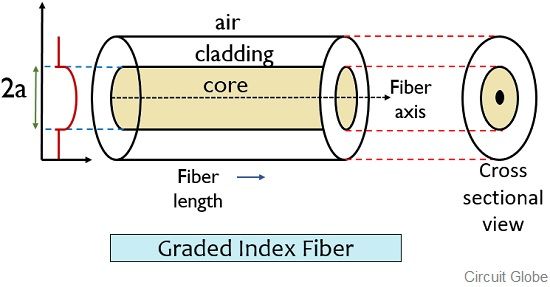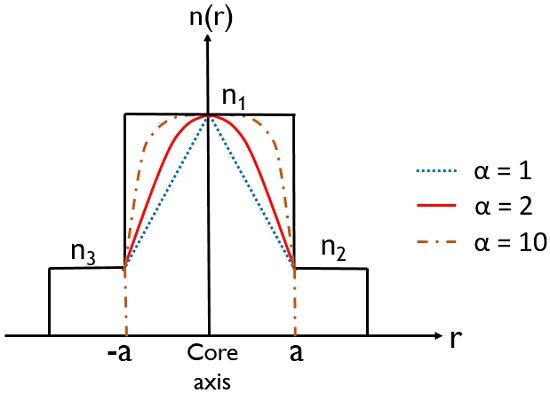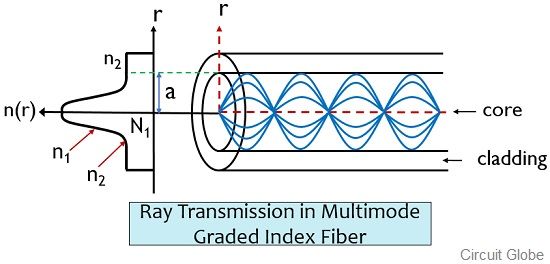Definition: Graded Index fiber is another type of optical fiber in which the refractive index of the core is non-uniform. This non-uniformity is present because the refractive index is higher at the axis of the core and continuously reduces with the radial movement away from the axis.
However, the refractive index of the cladding is constant in the case of graded index fiber. Hence the nature of the refractive index of the core is somewhat parabolic.
Unlike graded index optical fiber, the step index fiber has a constant refractive index at the core as well as cladding.
In the figure shown below you can see graded index fiber with its index profile:
In this type of fiber, the light ray experiences refraction thus gets bent towards the core. Thereby allowing propagation of ray in a curved path.
The refractive index of graded index fiber in the mathematical term is expressed as:
: a is the radius of the core
r is the radial distance from the core axis
α shows characteristic of the refractive index profile
n1 and n2 are the refractive indices of core and cladding respectively.
Let us have a look at the curve shown below that represents the variation in the profile of the refractive index with various values of α:
Graded-Index Multimode fiber
The diameter of core in graded-index multimode fiber is somewhat between 50 to 100 micrometer. The large diameter of the core allows multiple rays to propagate through the fiber.
The light wave that travels inside the fiber changes its behaviour with time while travelling inside it. As we have already discussed that the refractive index of the core at the axis is comparatively larger than at the other part inside it.
Thus when light is allowed is propagate inside the fiber, then it travels from less dense medium to more dense medium. However, we are aware of the fact that for TIR to take place the light must travel from denser to rarer medium. So, the light ray despite being reflected gets refracted inside the core.
Hence, the light on travelling gets continuously refracted and bends. Thus in case of graded-index multimode fiber, the light rays do not propagate by following a straight line, rather they follow parabolic path due to non-uniformity in the refractive index of the core.
However, some of the modes travel in a straight path or possess less parabolic nature. So, these light rays due to movement in high refractive index region propagate slower than those following a highly parabolic path.
The rays that propagate through the region that is away from the axis travels through the lower refractive index region, and travels longer path but propagates fastly.
So, this somewhat reduces the time to propagate at the other end of the fiber. Hence all the rays reach at the same time despite travelling through different paths.
This eliminates the chances of dispersion inside the core.
Advantages of Graded-Index Fiber
- It can transmit a large amount of information.
- The distortion is comparatively small than step index fiber.
Disadvantages of Graded-Index fiber
- These fibers possess low light coupling efficiency.
- It is somewhat expensive than step index fiber.
Thus from the above discussion, we can say that in the case of graded index fiber the transmitted information signal can be propagated efficiently and the chances of dispersion are also less in this case.




